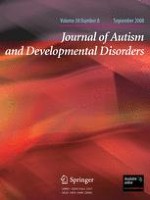01-09-2008 | Brief Report
Brief Report: Reliability and Validity of the Shared Activities Questionnaire as a Measure of Middle School Students’ Attitudes toward Autism
Gepubliceerd in: Journal of Autism and Developmental Disorders | Uitgave 8/2008
Log in om toegang te krijgenAbstract
The Shared Activities Questionnaire (SAQ) is a self-report measure of children’s behavioral intentions towards peers with disabilities. The SAQ has been validated as a measure of elementary school students’ attitudes towards peers with disabilities. In the present study, psychometric properties of the SAQ as a measure of middle school students’ attitudes toward autism were examined in a sample of 1,007 students (M age = 12.95 years). Confirmatory factor analysis supported the three-factor structure found for elementary school students. Internal consistency reliability was excellent. Criterion-related validity was established by demonstrating strong and positive relationships with a measure of cognitive attitudes. The SAQ is a reliable and valid measure of middle school students’ behavioral intentions towards autism.
